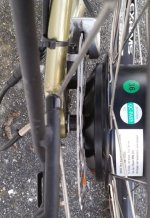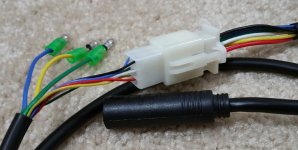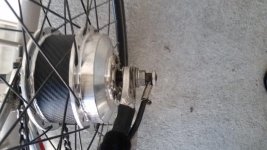molybdenum
1 kW
motomech said:The torque arm and the axle nut are too far out on the axle.
The TA should be clamped against the bottom of the chain stay and the nut should be inboard of the wire exit slot.
Do you have the fat washer/spacer in there? I think you need to replace it with a reg. flat washer.
Remember, when it's right, the wire should exit downward with a loop to prevent water ingress.
Then you should be able to fit the plastic end cap.
I see what you mean about the torque arms - not a lot of meat around the nuts. I did use the fat washer provided since it aligned them well with the dropout. I'll try switching to a thinner washer and mount the torque arms further up the chainstays.
motomech said:The BMSbattery order was perfect except they sent me a left handed thumb throttle; turns out, this arrangement fits the handlebars better anyway.
I don't think BMS B. sells a left-hand thumb throttle. I just flip the reg. thumb around when I mount it on the left and I suspect that is what you have done.
If you like the thumb on the left, you would have really liked the LH half twist i recommended you get.
When I flipped it around on the right side, the throttle wires were pointed away from the gooseneck and needed to be bent 180 to run down the frame. I don't mind it on the left, but I'll have another look, as I was tired and could have overlooked the obvious.
motomech said:Do you think the motor would have fouled the original brake disc/caliper?
I tried mounting the motor with the caliper in the original position with the 160 rotor and it impacted the motor. I had the extra parts on hand just in case (my measurements indicated it would impact by 5 mm), and went from a 160 to a 180mm to fit the motor. I'll post a clearer pic to illustrate the clearance with the new 180 rotor later tonight.
motomech said:Looking forward to the performance report.
I had to scrub my morning test run as I ran into an "03 info" error, which according to the LCD-3 manual, indicates a hall sensor fault. I didn't have time to troubleshoot this morning before work, but I'll test the motor hall sensors with and without the motor cable, then check the connections to the controller - it should be fairly easy to sort out what's wrong.








